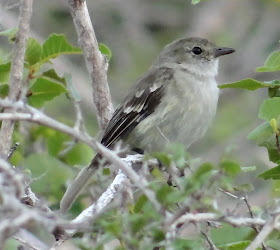The next morning we left very early for a 2.5-hour drive
to the Continental Divide in the area where the borders between Chiriqui and
Bocas del Toro provinces define the
Pacific slope to the south and the Caribbean slope to the north. We spent the
day birding trails and roads on both slopes.
We were fortunate that many trees and shrubs were flowering;
we had hummingbirds in abundance. White-bellied Mountain-Gem and
Purple-throated Mountain-Gem were present in small numbers along our first road
on the Pacific slope, along with a pair of unexpected Snowcaps (a third was
seen later). Also unexpected were 6-8 Black-bellied Hummingbirds – a
difficult species in its limited range. Green-crowned Brilliant and Violet-headed
Hummingbird were among other hummers seen this day.
A highly vocal Costa Rica Pygmy-Owl attracted large numbers of hummingbirds and
other species, notably a much wanted endemic - Blue-and-gold Tanager. Other birds buzzing the owl included Tawny-capped Euphonia,
Black-and-yellow Tanager and Common Bush-Tanager.
Our second morning at Boquete was spent wandering the very pleasant local
road and trails at a leisurely pace.
A Hercules Beetle found by Tau was very
nice.
Brown Violetear and Philadelphia Vireo were among the birds
that were about.
In the early
afternoon we moved east to San Felix -
our final destination before returning to Panama City. We made a return visit to Las Lajas (seeing
following post) in the late afternoon. Early the next morning we headed north to
Cerro Santiago, our third big birding site for the trip in the west Panamanian
mountains. We had a Dusky Nightjar calling right by the car as we stopped
before dawn, with the bird showing well enough and another calling nearby. It was not long before we connected with our main target
hear – the endemic and endearing Yellow-green Finch.
 |
| Yellow-green Finch - Pic by Ketil Knudsen |
Streak-breasted Treehunter was another nice find and there
seemed to be quite a few around.
 |
| Streak-breasted Treehunter - Pic by Ketil Knudsen |
In beautiful conditions in the pleasant early
morning we saw other birds including Golden-browed Chlorophonia and Ruddy Treehunter. Then we embarked on the long return drive to Panama City for the final leg of our three-week sojourn.
 |
| Cerro Santiago |
This trip was not without challenge. The Darien and Cerro Pirre in particular were never going to be easy for a large group and we had our share of ups and downs. There were unfortunately one or two significant personality issues; these may be pursued in less public forums so that other groups may learn from our experience. The organisation by Birding Panama was first-class and a credit to them, notwithstanding a few hiccups along the way. Our guide Euclides (Kilo) Campos was superb and is highly recommended. Our driver Francisco was always happily up for the very early starts and long drives.
 |
| White-bellied Mountain-Gem |
Most importantly, we had great success on this trip birdwise with a total list of about 600 species. Star birds included: Black-eared Wood-Quail, Agami Heron, Crested Eagle, Plumbeous Hawk, Rufous-vented Ground-Cuckoo, Costa Rica Pygmy-Owl, Dusky Nightjar, Tooth-billed Hummingbird, Veraguan Mango, White-bellied Mountain-Gem, Snowcap, Black-bellied Hummingbird, Pirre Hummingbird, Yellow-eared Toucanet, Blue-fronted Parrotlet, Lattice-tailed Trogon, Resplendent Quetzal, Tody Motmot, Barred Puffbird, Grey-cheeked Nunlet, Stripe-cheeked Woodpecker, Crimson-bellied Woodpecker, Sulphur-winged Parakeet, Spot-crowned Barbet, Tody Motmot, Speckle-faced Antbird, Ocellated Antbird, Wing-banded Antbird, Black Ant-shrike, Black-crowned Antpitta, Speckled Antshrike, Streak-breasted Antpitta, Ochre-breasted Antpitta, Black-headed Ant-thrush, Sapayoa, Brown-billed Scythebill, Silvery-fronted Tapaculo, Streak-breasted Treehunter, Slaty-winged Foliage-gleaner, Beautiful Treerunner, Speckled Mourner, Double-banded Greytail, Yellow-green Tyrannulet, Ochraceous Peewee, Russet-winged Schiffornis, Blue Cotinga, Sharpbill, Silvery-throated Jay, Sooty-headed Wren, Stripe-throated Wren, Varied Solitaire, Pirre Warbler, Zeledonia (Wrenthrush), Green-naped Tanager, Blue-and-gold Tanager, Pirre Bush-Tanager,Viridian Dacnis, Orange-collared Manakin, Green Manakin, Yellow-green Finch, Black Oropendola.
Thanks to Ketil Knudsen for the use of some of his superb pics after I drowned my camera. Six more blog posts from the trip follow. A full trip report will be published in due course.

























































